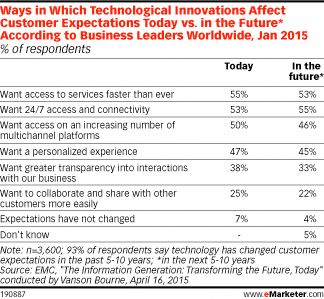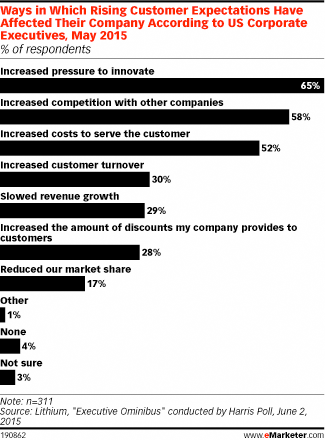Can Companies Keep Up with Soaring Customer Expectations?
June 17, 2015
![]() Exceptional service? Customers like it, and they want more. In May 2015 polling by Harris Poll for Lithium, 82% of US corporate executives said that customers’ expectations of their company were “somewhat” (47%) or “much” (35%) higher than they were three years ago. And it’s not easy to keep up, as nearly six in 10 said it was “somewhat” (50%) or “very” (9%) difficult for their company to please customers.
Exceptional service? Customers like it, and they want more. In May 2015 polling by Harris Poll for Lithium, 82% of US corporate executives said that customers’ expectations of their company were “somewhat” (47%) or “much” (35%) higher than they were three years ago. And it’s not easy to keep up, as nearly six in 10 said it was “somewhat” (50%) or “very” (9%) difficult for their company to please customers.
 What’s to blame for the boost in pressure? A little thing called technology. Fully 77% of corporate execs polled by Lithium agreed to some extent that the internet and consumer app companies were setting a new benchmark for customer experiences. Similarly, in a January 2015 study from EMC conducted by Vanson Bourne, 93% of business leaders worldwide said technology had changed customer expectations in the past five to 10 years.
What’s to blame for the boost in pressure? A little thing called technology. Fully 77% of corporate execs polled by Lithium agreed to some extent that the internet and consumer app companies were setting a new benchmark for customer experiences. Similarly, in a January 2015 study from EMC conducted by Vanson Bourne, 93% of business leaders worldwide said technology had changed customer expectations in the past five to 10 years.
 Further responses gave more insight into the effect technology was having on customer expectations. The majority of business leaders worldwide said customers wanted access to services faster than ever as well as 24/7 connectivity due to technological innovations, and half wanted access on an increasing number of multichannel devices. Personalization, transparency and collaboration were also trending.
Further responses gave more insight into the effect technology was having on customer expectations. The majority of business leaders worldwide said customers wanted access to services faster than ever as well as 24/7 connectivity due to technological innovations, and half wanted access on an increasing number of multichannel devices. Personalization, transparency and collaboration were also trending.
The Lithium study found similar results, with 97% of US corporate executives saying customers wanted an efficient—that is, fast, cost-effective and personalized—level of experience.
Companies were certainly feeling the heat. Nearly two-thirds of corporate execs said rising customer expectations had increased pressure to innovate, and nearly six in 10 said the same about competition with other companies. In addition, companies were spending more to satisfy consumers. Three in 10 struggled with customer turnover or slowed revenue growth, and a similar percentage had increased discounts given.
With customer expectations higher than ever due to technology, the pressure is on for marketers to keep up with tech-savvy, always-on consumers—or risk getting trampled by the competition.
Courtesy of eMarketer




























